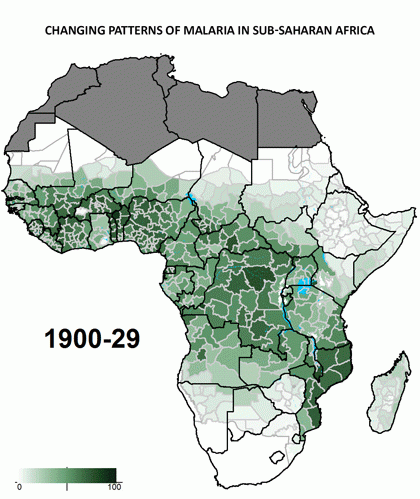New access to old datasets provides huge potential in fight against malaria
In a letter published by Nature this month, Snow et al have contributed significant insight into the multifaceted interactions affecting malaria transmission rates on the African continent over the past 115 years.
The integration of malaria surveillance data with information on climate, land use, antimalarial availability and resistance, international funding trends, vector control programmes and bed net distribution, has elucidated the complexity of these dynamics and highlights the limitations of the current malaria-control arsenal.
Holistic approach to fighting malaria needed
The results of the study emphasise the need to maintain a holistic approach to the fight against malaria. The reduction in infections and deaths over the past century is not a straight downward trend.
Peaks and troughs litter the prevalence graph along a timeline of natural climatic changes and man-made interventions. It is clear that no single therapeutic, insecticidal, meteorological or other silver bullet will ensure elimination.
This compilation of lessons from the past must be heeded to avoid a repeat of the many pitfalls that have plagued previous efforts. However, while the malaria community is unlikely to have immediate effect on the rising temperature or variable rainfall, there is opportunity for impact.
Successful interventions to fight malaria are within reach
It is within reach to sustain successful interventions like vector control, and to minimise the risk of drug-resistance fuelled resurgences like those caused by chloroquine and sulfadoxine-pyrimethamine resistance in the 1990s and early 2000s.
We can strengthen future strategies by understanding the drivers that caused interventions to fail in the past and focusing our efforts on optimising the success of current and novel interventions.
Key gap in malaria-control arsenal

In addition to the valuable analysis, the study highlights a key gap in the tools needed to maximise the potential of human impact: the data.
As an interview with the lead author explains, retrieving malaria parasite examination results of more than 7.8 million blood samples from 30,000 villages was a 21-year effort which traversed the dusty private basements of retirees, institutional store rooms both full and empty, and the deepest medical archives across two continents.
Many records were irretrievable: lost, burnt, forgotten or misplaced leaving gaping holes in our collective knowledge. Both the incompleteness of this record and the time spent to assemble it should serve as a wakeup call to those interested in continuing the downward trend of malaria prevalence.
For example, careful monitoring of resistance markers and therapeutic efficacy can ensure that the available antimalarials are used most effectively, thus minimising the spread of resistance and prolonging the clinical usefulness of existing treatments. But this approach is useful only when the data are made readily available to those making clinical and policy decisions.
New data has great scientific potential
Despite the advent of the digital age and the open data sharing movement, much of the data that could inform a rapid, collective response to the growing threat of antimalarial resistance remain securely siloed in institutional archives without sufficient efforts to make them accessible and useful.
Perhaps the most important contribution from Snow and his colleagues is the huge data sets that they have collected, curated, securely archived, and made openly available.
They have assembled and organised a rich archive of precious history for other researchers to explore their own hypotheses. The scientific potential of the data has been optimised by enabling access, but the full impact of this effort will only be achieved when the hundreds of individuals and institutions who contributed to the effort commit to prospectively make such data available for use by the research and public health communities.
Power of collaborative data sharing
Initiatives such as the WorldWide Antimalarial Resistance Network have proven the power of collaborative data sharing by assembling and harmonising individual patient data sets to track the spread of resistance and optimise the use of available treatments.
This type of dedicated collaborative repository also secures the long-term storage of data for future analysis and assures that these data can be used and reused, as exemplified by those now presented to the malaria community by Snow and his colleagues.
The digital age offers new and innovative opportunities for collaboration that weren’t available to many of those who generated the records that have been collated.
It brings with it a responsibility to work together to minimise the peaks in malaria prevalence and contribute to an uninterrupted downward trajectory.
This news article was written by Laura Merson.
Laura Merson works with the Infectious Diseases Data Observatory (IDDO) to develop platforms that synthesise global health data to generate reliable evidence and research-driven responses to major challenges in poverty-related diseases and emerging infections.